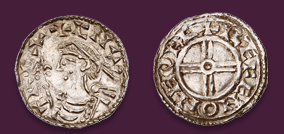
Auction: 15002 - Orders, Decorations, Campaign Medals and Militaria
Lot: 24
The Exceptional, and Unique to Regiment, 1914 D.C.M. and 'St. Eloi' Dated Bar Group of Five to Sergeant J. Maher, Leinster Regiment, Who Died of Wounds, 9.5.1915, During the Battle of Frezenberg
a) Distinguished Conduct Medal, G.V.R., with Second Award Bar dated, '15th March 1915' (7622 L.Cpl. J. Maher. 2/Leins: Regt.)
b) 1914 Star, with Bar, unnamed
c) British War and Victory Medals (7622 Cpl. J. Maher. Leins. R.)
d) Russia, Imperial, Cross of the Order of St. George, Fourth Class, silver, reverse officially numbered '127346', generally very fine or better, mounted for wear by Spink & Son Ltd, St. James (5)
D.C.M. London Gazette 1.4.1915 7622 Lance-Corporal Maher, J., 2nd Battalion, Leinster Regiment
'For gallant conduct at Prémesques on 20th October, 1914, in carrying messages on numerous occasions under heavy fire. Was previously bought to notice for gallantry on 23rd September at Cour de Soupir, when he brought up food to the trenches whilst exposed to heavy shell fire.'
D.C.M. Second Award Bar London Gazette 3.6.1915 7622 Serjeant Maher, J., 1st Battalion, Leinster Regiment
'For conspicuous gallantry, marked ability, and coolness, at St. Eloi on 15th March, 1915, when he took command of the trench after his Officer had been killed and repulsed the attack of a very superior force, inflicting great losses on the enemy.'
Russia, Cross of the Order of St. George, 4th Class London Gazette 25.8.1915 7622 Serjeant John Maher, 1st Battalion, Leinster Regiment
'For gallantry and distinguished service in the field.'
7622 Sergeant John Maher, D.C.M., born Callan, County Kilkenny, Ireland; served during the Great War with the 2nd Battalion Leinster Regiment on the Western Front from 8.9.1914.
Last Days On The Aisne
Maher served with the battalion as part of the 17th Infantry Brigade (comprising of the 2/Leinsters, 1/Royal Fusiliers, 1/Prince of Wales's (North Staffordshire Regiment), 3/Rifle Brigade), 6th Division, and arrived with them on the Aisne, 'On the 16th September... the 6th Division, delayed in transport by the shifting of the British base from Havre to St. Nazaire, arrived in rear of the III Corps. It was temporarily broken up in order to provide relief to the war-worn troops of the first five divisions. The 17th and 18th Brigades were attached to I Corps, and the 16th to II Corps. The 17th Brigade became corps reserve... On the 17th a supply of entrenching tools reached the II Corps, and from that date its casualties sensibly diminished. On the 19th arrived the first 18-pdrs. to make good part of the losses of II Corps at Le Cateau; and from that day forward a stream of drafts poured in to fill the gaps of the battalions... On the 23rd and 24th nothing of importance took place on the Aisne, although there were the usual desultory attacks and the usual bombardment [see D.C.M. citation above]. Opportunity was taken to carry out reliefs. For instance, the 17th Brigade took the place of the 5th, whose brigadier, General Haking, had been wounded, and the latter brigade was withdrawn into corps reserve' (Official History of the War, Military Operations, France and Belgium 1914, Vol. I, refers).
The Eve of The Battle of Ypres, The Attempt To Secure Pérenchies Ridge
By the second week of October 1914 the Germans were entrenched on a low ridge between Lille and Arementières. General Pulteney gave orders for the 4th and 6th Divisions to act in concert to drive back the enemy forces from Pérenchies Ridge. He therefore ordered 'the 6th Division to test the strength of the Germans holding the line some three miles long from La Vallée to Pérenchies, to push them back if they were weak, but to wait for the co-operation of the 4th Division if they were strong. The 4th Division was ordered to attack Frélinghien from both sides of the river.
General Keir (6th Division), in consequence, sent the 18th Brigade (Br.-General W.N. Congreve) at 6.30am [18.10.1914] against the sector La Vallée-Paradis (just south of Prémesque) and the 17th (Br.-General W.R.B. Doran) against Prémesques-Pérenchies, each with an artillery brigade attached... The reconnaissance of the 17th and 18th Brigades... soon developed into an action. In the 18th, the 2/Durham Light Infantry and 1/West Yorkshire reached their objectives towards 11am, after encountering only slight resistance. On their left in the 17th Brigade the 2/Leinster and 3/Rifle Brigade sent against Prémesques and Pérenchies respectively, both met with continuous opposition as they moved up the slopes in front of them; but by 10am the Leinsters were on top of the ridge, in Prémesques and in sight of Lille. They could not get further and, finding the enemy strongly entrenched south-east of them, they dug in and waited.' (Ibid)
By nightfall, despite the best efforts to push on the two divisions ground to a halt, with the 'Leinsters of the 17th Brigade, although in the village of Prémesques, were unable to master the Mont de Prémesques, which lies immediately south of it...
The 17th Brigade on the left of the 18th... was unable to make progress, and at 5pm when still on the line Prémesques-Epinette was ordered to entrench. Its right battalion, the Leinsters, had got nearer to Lille than British troops were to be for many a long day.' (Ibid)
The early hours of the 20th October (see D.C.M. citation above) heralded the first day of the attack of the German Sixth and Fourth Armies, and the loss of Prémesques, 'North of the 18th Brigade, the Leinsters, holding the front line of the 17th Brigade, Prémesques-Epinette, had been fired on from 2am onwards. Then at 8am, after heavy shelling for three-quarters of an hour, enemy infantry of the 24th Division of the XIX Corps stormed Prémesques.
To this direction, therefore, the available reserves of the 6th Division were diverted, sadly denuding the strength of its right. The East Yorkshire on the right of the Leinsters sent first one and then a second company to their assistance. This stopped further German progress, but the first company was driven back by superior numbers, and the East Yorkshire eventually threw back their left to form a defensive flank.' (Ibid)
Despite the best efforts of the Leinsters the German numbers were overwhelming and Prémesques was lost. The 6th Division had to fall back two miles on the right and centre and a quarter of a mile on the left.
St. Eloi
Maher transferred to the 1st Battalion Leinsters, and was in action with them as part of the 82nd Infantry Brigade, 27th Division, at St. Eloi 14/15.3.1915, 'On the 14th March the Germans made a surprise attack at 5pm on a larger scale at St. Eloi, firing two mines. They captured the village, the trenches near it, and the "Mound" (an artificial heap of earth about thirty feet high, and perhaps half an acre in extent, on the western side of the knoll south of the village)... There was severe hand-to-hand fighting, in which the 2/King's Shropshire L.I. and 4/Rifle Brigade particularly distinguished themselves. An immediate counter-attack could not be made, as owing to the heavy shelling no reserves were kept near at hand; but after midnight one was carried out by Br.-General J.R. Longley (82nd Brigade) with the 1/Royal Irish and 1/Leinster of his own brigade and the 4/K.R.R.C. of the 80th. He recovered the village and the trenches, although part of the latter had to be evacuated at daylight, after Lieut.-Colonel G.F.R. Forbes of the Royal Irish had been wounded. The "Mound", which gave good observation, was not recaptured, the Germans having at once consolidated their position on it.' (Official History of the War, Military Operations, France and Belgium 1915, Vol. I refers)
The 1st Battalion Leinsters were heavily engaged in the Battle of Frezenberg Ridge, 8th-13th May 1915; Maher died of wounds, 9.5.1915, and is commemorated on the Ypres (Menin Gate) Memorial.
The above is the only D.C.M. and Second Award Bar to Leinster Regiment for the Great War.
Subject to 20% VAT on Buyer’s Premium. For more information please view Terms and Conditions for Buyers.
Sold for
£7,500




